This week I satisfyingly ticked off one line on my very long and ever-growing bucket list: “Take cooking classes at a French cooking school!”
The options for French cooking classes in France, and Paris in particular are varied and suitably pleasing- catering to all tastes, budgets and availability. From week-long stays in lush Normadie Château’s to day-classes with market field trips or compact two-hour studio-style classes, France is certainly a country which obligingly shares and flaunts the many secrets and attributes of her cuisine.
For my purposes, with a limited schedule, and of course through recommendation, I booked a two-hour afternoon class at one of the more well known French Schools- Atlelier des Chefs. With classes in all major regions across France and a huge selection of menus and techniques to choose from packed into 2.5 hours for €70, a friend I booked ourselves into the last 2 spots for a specialised class in techniques for selecting, preparing and cooking salmon demonstrated over three different dishes.
The French are huge consumers of salmon. Salmon is the No 1 most consumed fish in France generally, with France being the No 1 smoked salmon consumer in the EU, ahead of Germany. Salmon features frequently in French dishes both classic and modern and is a delicious, versatile and readily available staple. Farmed fresh salmon was used in our cooking class, since wild salmon is more difficult to source, and generally much more expensive.
Whilst on the topic, it’s worthwhile touching on a growing concern and hot topic right now making waves not only in France but globally- the sustainability and health implications of the farmed salmon industry.
Today, over 50 per cent of the world’s salmon supply is farmed salmon. There are huge ramifications of mass fish farming environmentally and to our health- with some studies reporting that farmed fish contains 8-10 x the toxicity levels of wild salmon, meaning that just one portion of this fish per month can be consumed in order to remain under healthy levels.
Aside from health considerations, the world’s oceans are really feeling the effect of increasing global demand. Farmed salmon produced just in British Columbia’s 100 plus open-net-cage salmon farms produces waste roughly the same as the raw sewage from a city of half a million people. Sadly I’m finding it harder and harder to eat these days without feeling guilty about where my food came from!
This is no small topic and really requires an article all to itself, so instead here’s some good food for thought on the topic since it’s definitely worthwhile reading up on.
- Gourmet.com article on Obama’s move to open the Gulf of Mexico to unregulated, industrial-scale open-water fish farms
- Download the “End of the Line” Widget to check whether the fish you are planning to buy or eat is caught or farmed in a way that is sustainable
- Advice from the World Health Organisation on PCBs and dioxins in salmon
- Greenpeace’s take on the debate
- What the farmed fish industry says
Now, before you download that sustainable fish iphone app or book in a panicked blood test to check your mercury levels, sit back and enjoy a visual snapshot of The Atelelier chef’s experience – including the recipe for my favorite dish from the day- Green tea infusion-steamed salmon with seasonal wok vegetables (Saumon à la vapeur de thé, wok de légumes croquants)!
How to select and prepare fresh salmon
Our host chef and teacher for the class- “Matthieu” enthusiastically explained (in French) the key points to look for to ensure freshness and quality- here is my best shot at the translation:
Smell: if it smells like fish- move on! The odor indicates that the fish is old and hasn’t been kept at appropriate temperatures.
Flesh: should be in firm shape and should bounce back when pressed gently.
Skin: Should be clean and shiny- never not slimy.
Eyes: The eyes should be clear, bright and well rounded.
Colour: Apparently the best way to gauge the freshness of a whole fish is by looking inside/behind the gills. “Les ouïes” should be bright pink to deep red in colour- signifying a high level of oxygen still present and a suitable state of freshness.
Preparing Salmon:
Matthieu gave a detailed demonstration of the de-boning process or removal of ‘les arêtes.’ Working down the spine from the tail end to the head, each bone must be removed one at a time using a pincer- taking care to pull gently in the same direction as the bone sits- as to ensure the flesh is not bruised in the process. There is one smaller bone at the head-end which takes some fiddling to find but should obviously not be missed.
Cutting the fillet
The tail end is typically used for raw dishes- sushi, maki, sashimi, and the meatier, thicker sections cut in 150 gram portions for cooking.
Personally, I am never quite sure if my vegetable-cutting technique is cuts it… Thankfully, preparation methods were covered thoroughly in our class with special techniques and cuts detailed for each vegetable. Some vegetables shown here were used in the Provençal vegetable ratatouille, the remainder were used for the wok veggies in the following recipe steamed salmon infused with green tea.
Our chef demonstrated 3 dishes in the class, but for this post I will just focus on the detail for the provided recipe:
Green tea infusion-steamed salmon with seasonal wok vegetables
A simple, healthy and original way to serve salmon with an asian infusion- enjoy!
Ingredients:
Serves 6
6 Salmon steaks (150 grams each)
Green tea powder: 10 grams
2 x quality earl grey tea bags or spiced tea such as cardamom or chai
Fine sea salt: 5 grams
Fleur de sel: 6 pinches
Carrots: 2 (med-large)
Green onions: 1 bunch
Red Radishes: 1 bunch
Shitake Mushrooms: approx 1 dozen
Peanut oil
Filtered water
Instructions:
Peel the carrots and onion, cut carrots in half lengthways then again in fine strips on 45 degree angles (as pictured). Finely dice onion chives. Clean and slice the radishes into 4 lengthways leaving 1cm of green shoot attached at stem. Remove stems and dice Shitake mushrooms.
In a wok, add a drizzle of peanut oil and sweat the onions with a pinch of salt. Add the carrots with another pinch of salt and a glass of water. Cover and cook for 2-3 minutes. Add the radishes and shitake mushrooms. Adjust seasoning. Add a glass of water and add teabags to wok.
In the same wok, insert a wire rack and place salmon steaks seasoned with salt and green tea. Cover wok with lid cook for 8 minutes allowing steam vapour to infuse through salmon and the vegetables.
Arrange the vegetables onto plates and arrange the salmon steaks on top. Finish with a pinch of fleur de sel and serve.
Demonstration of cooking techniques from the 2 other dishes prepared during the class:
– Saumon rôti aux épices, sauce raïta et épinards
– Pavé de saumon cuit à l’unilatérale, cocotte de légumes provençaux
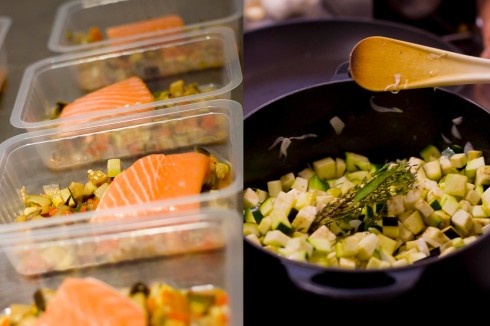
Provencal vegetables and grilled salmon- packed up to take home, courgette cooking in cocotte for Provencale vegetables
Voila!
Happy cooking and some final pics from the day…

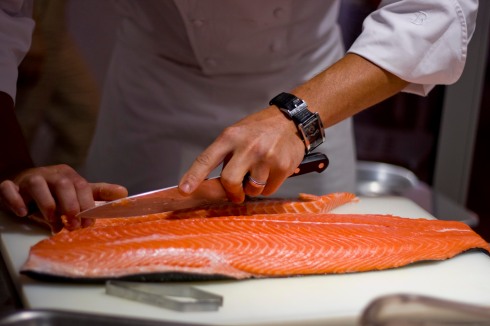
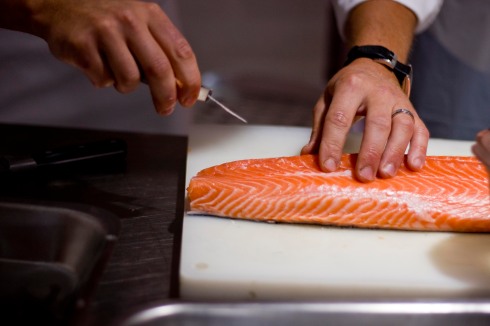
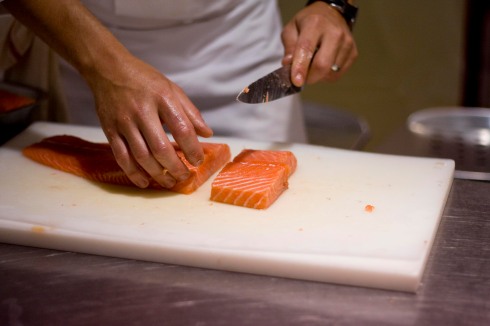
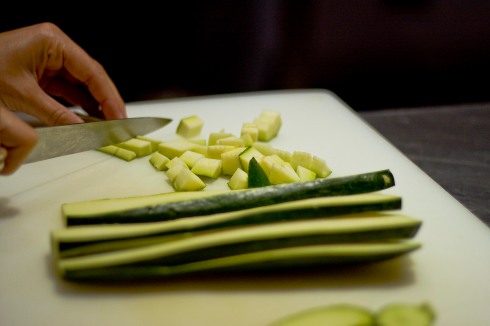
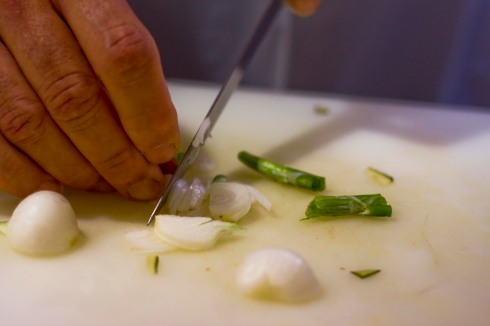
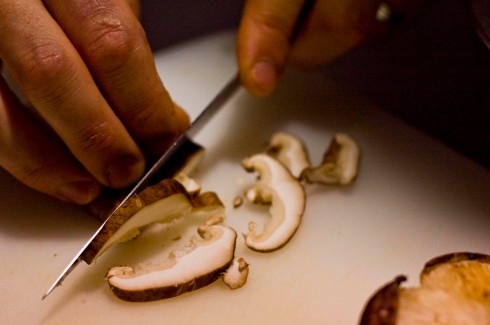
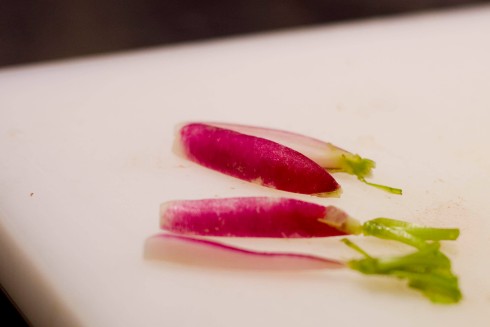
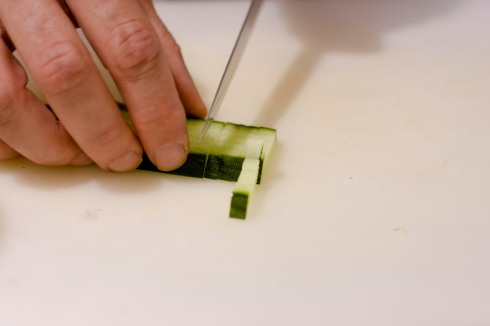
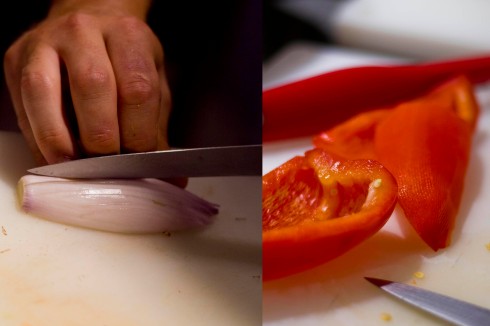
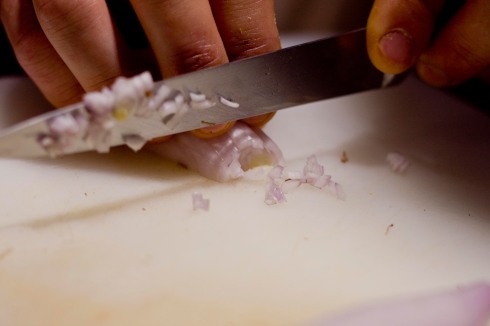
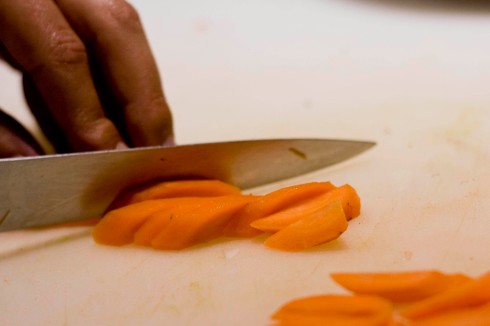
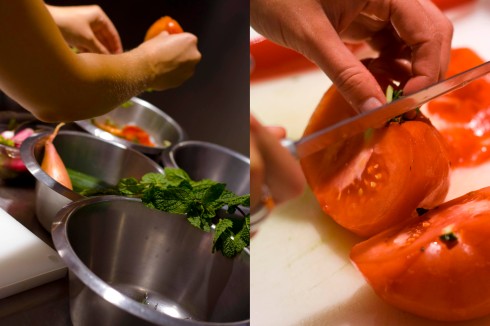
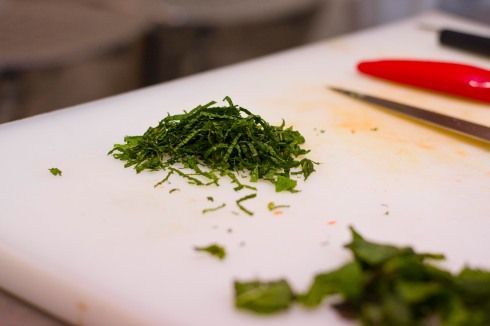
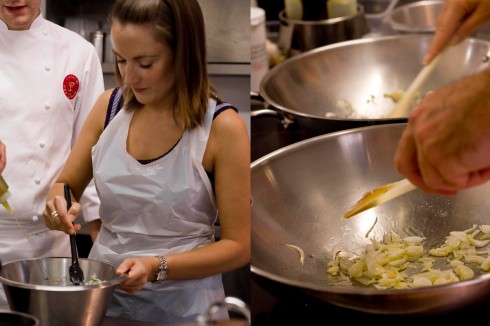
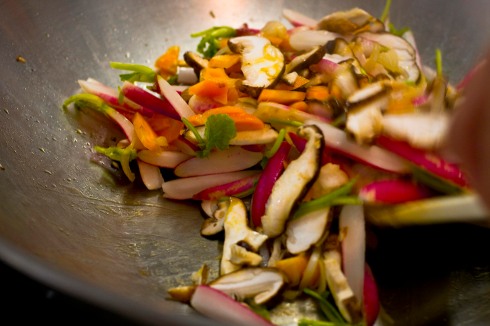
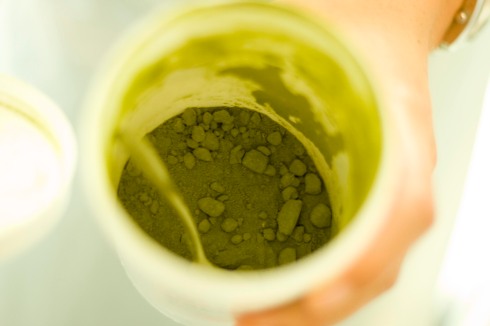
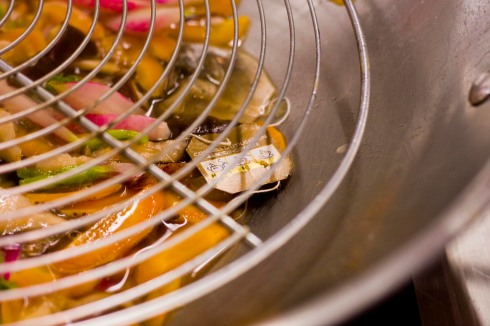
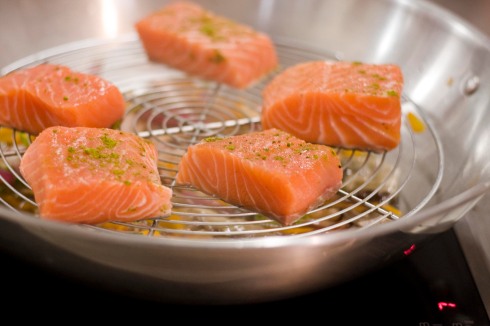
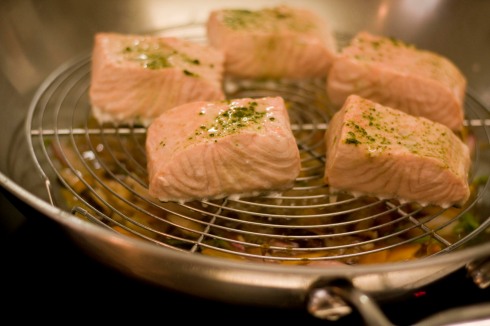
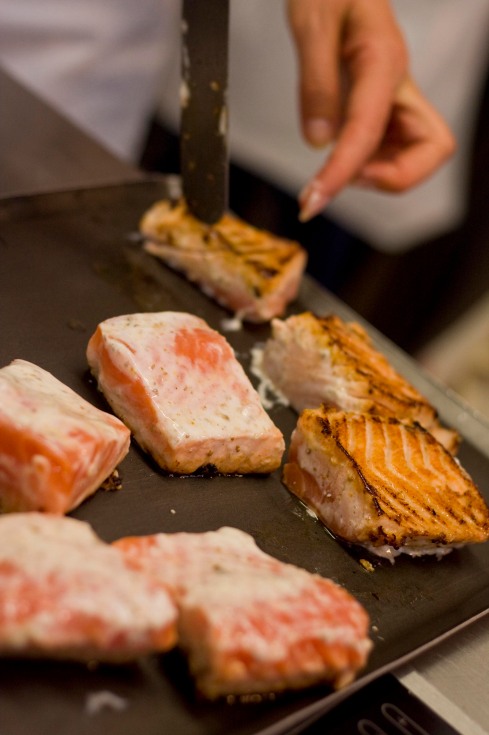
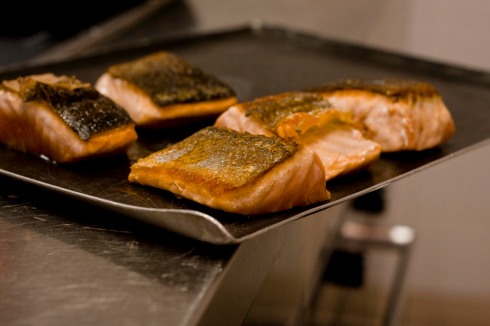
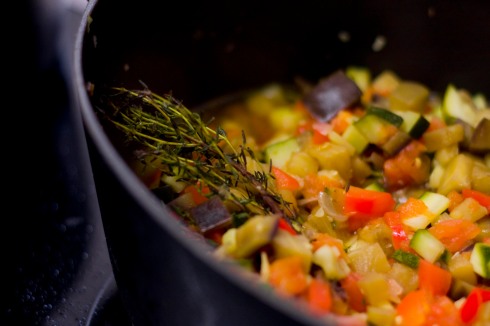
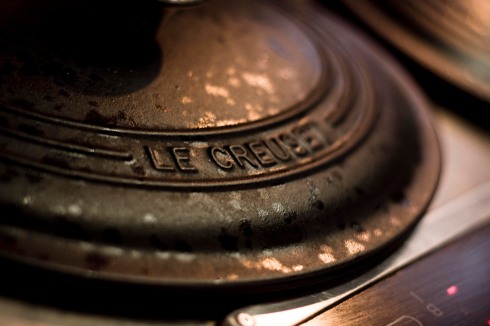
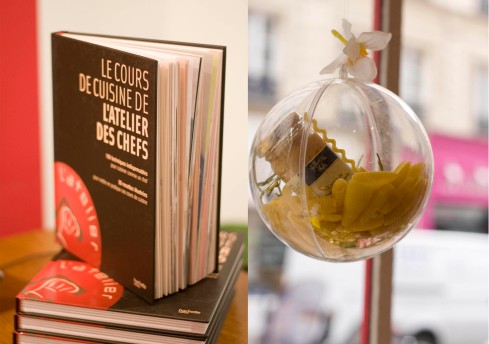

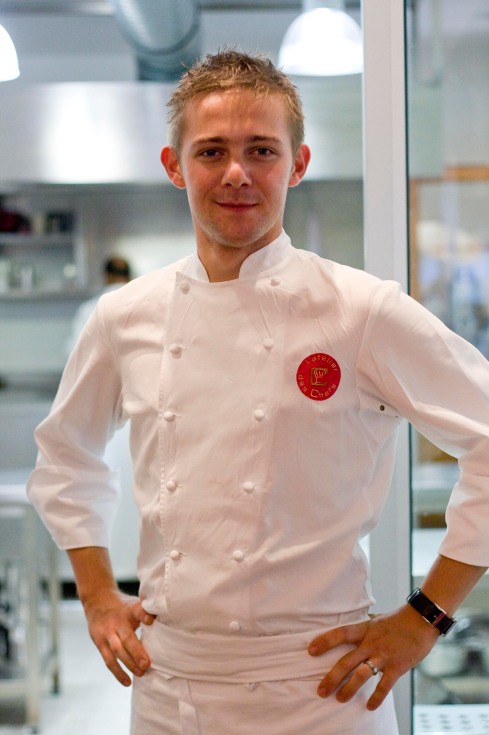














What a beautiful post! Enjoyed every word and picture!
For years I’ve questioned the need for the internet.
Finally! A website I can relate to. The photography is exquisite and the gastronomic premise is good-wholesome fun.
My stomach is grumbling!
_R
Really great post Rachel. Now I am HUNGRY! Fi x
What a fabulous post Rachel – I highly enjoyed reading about Salmon!